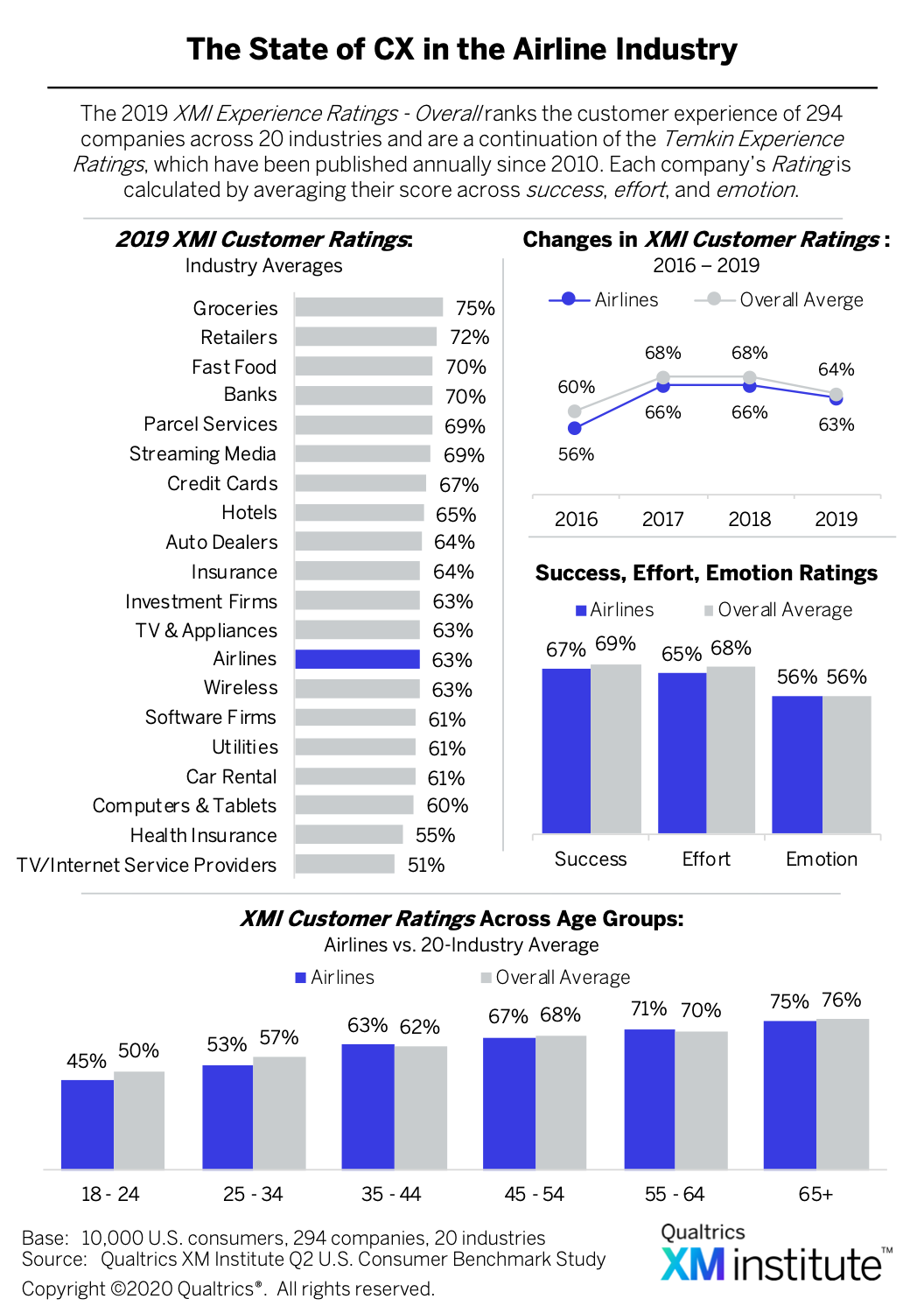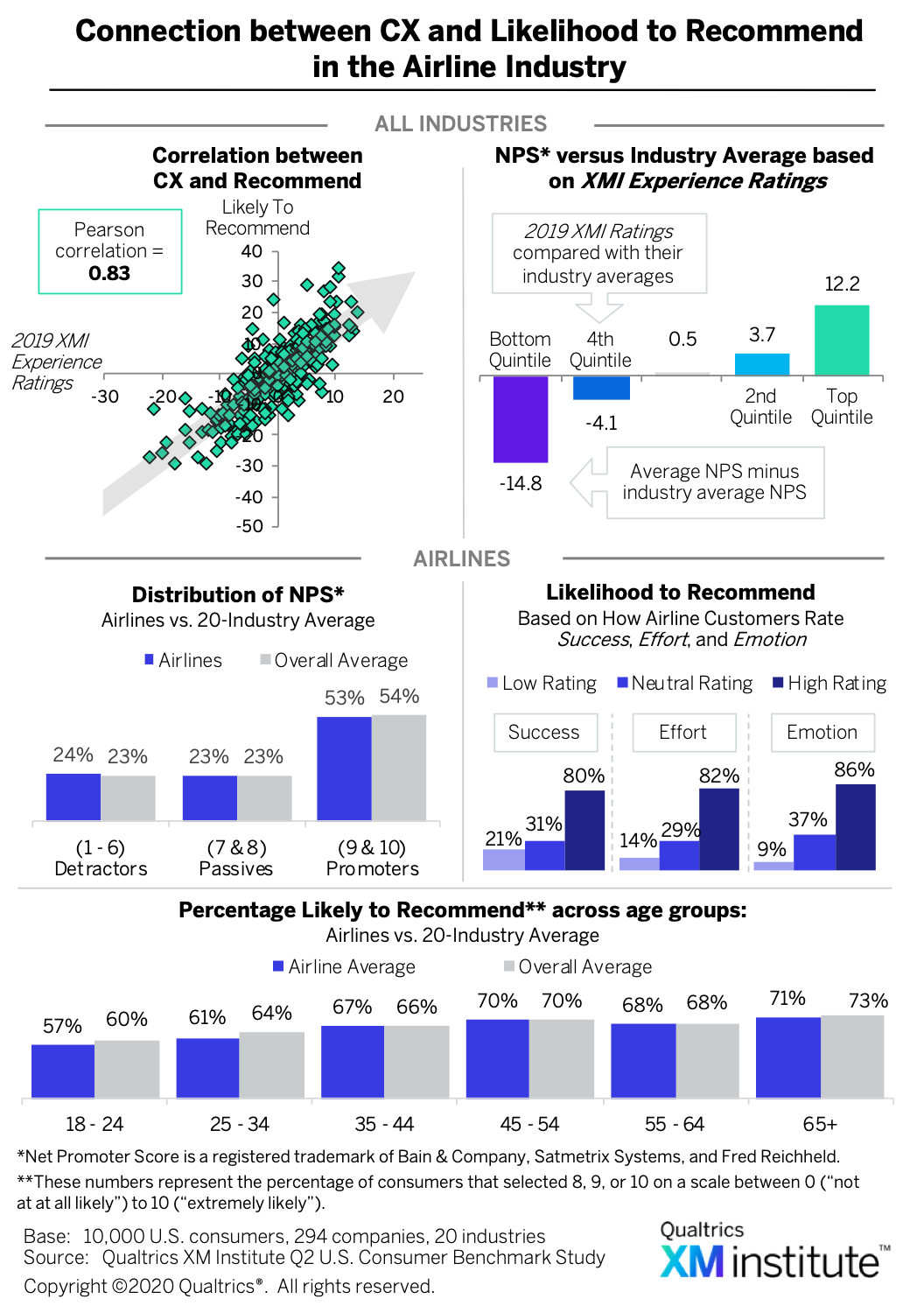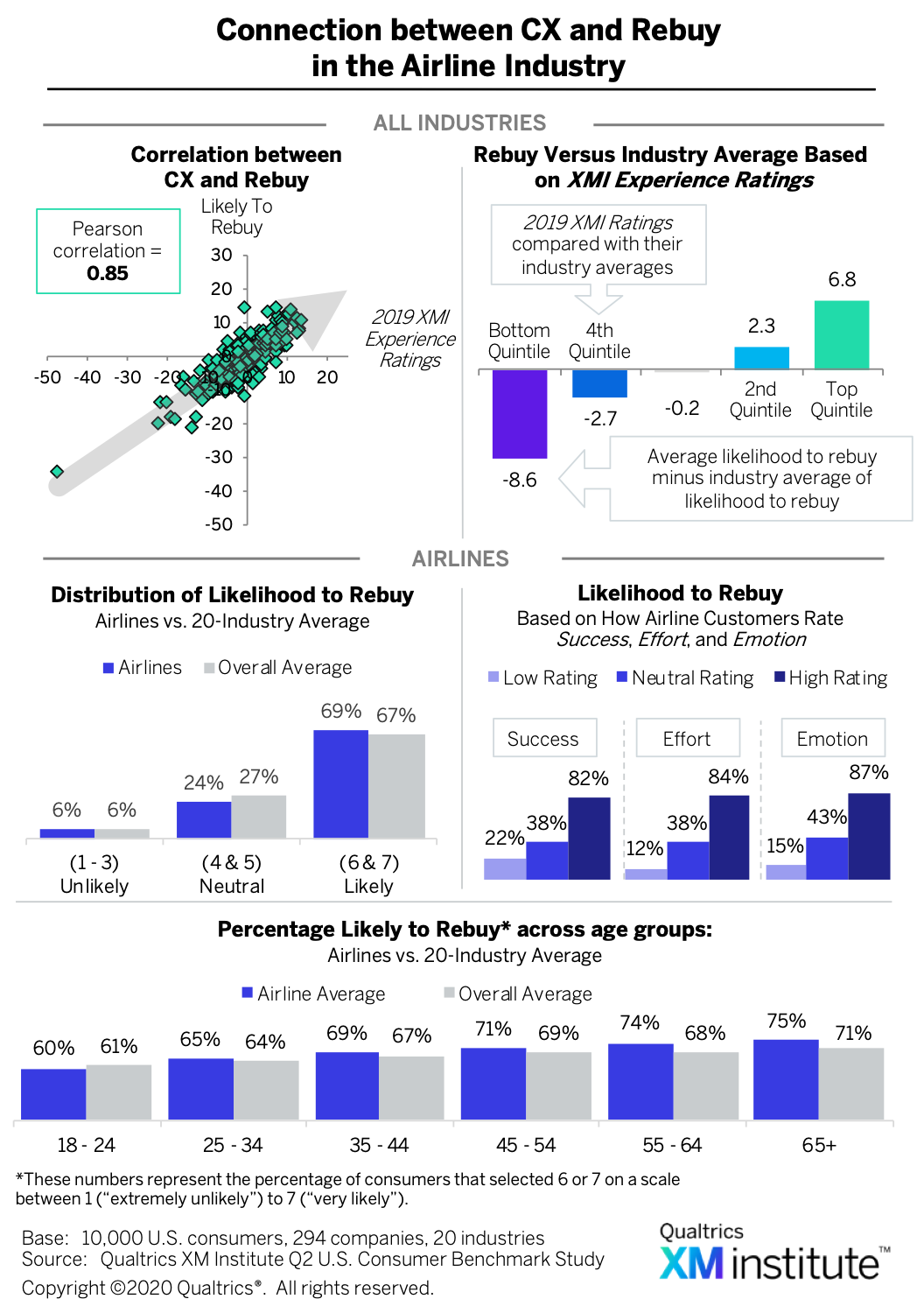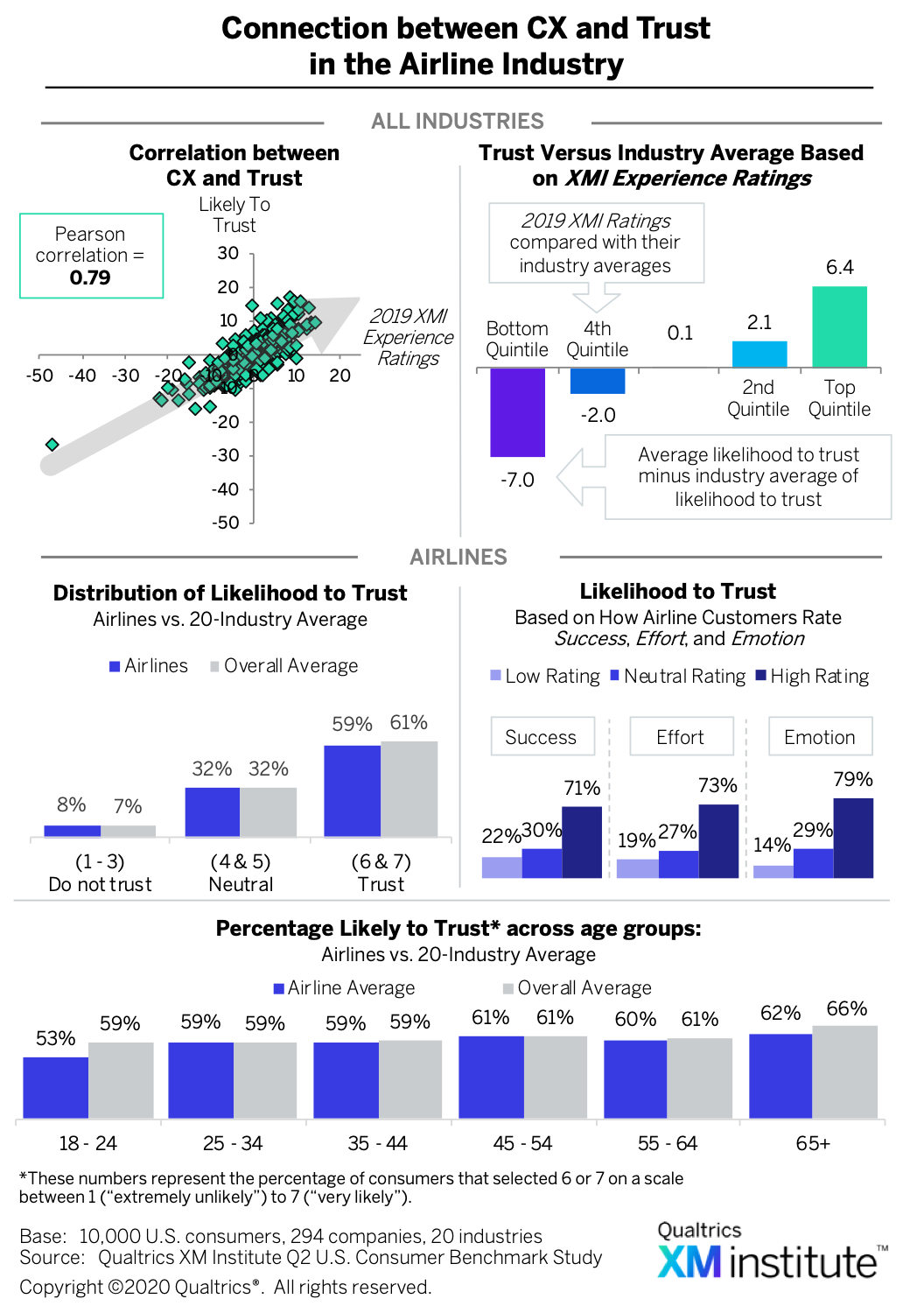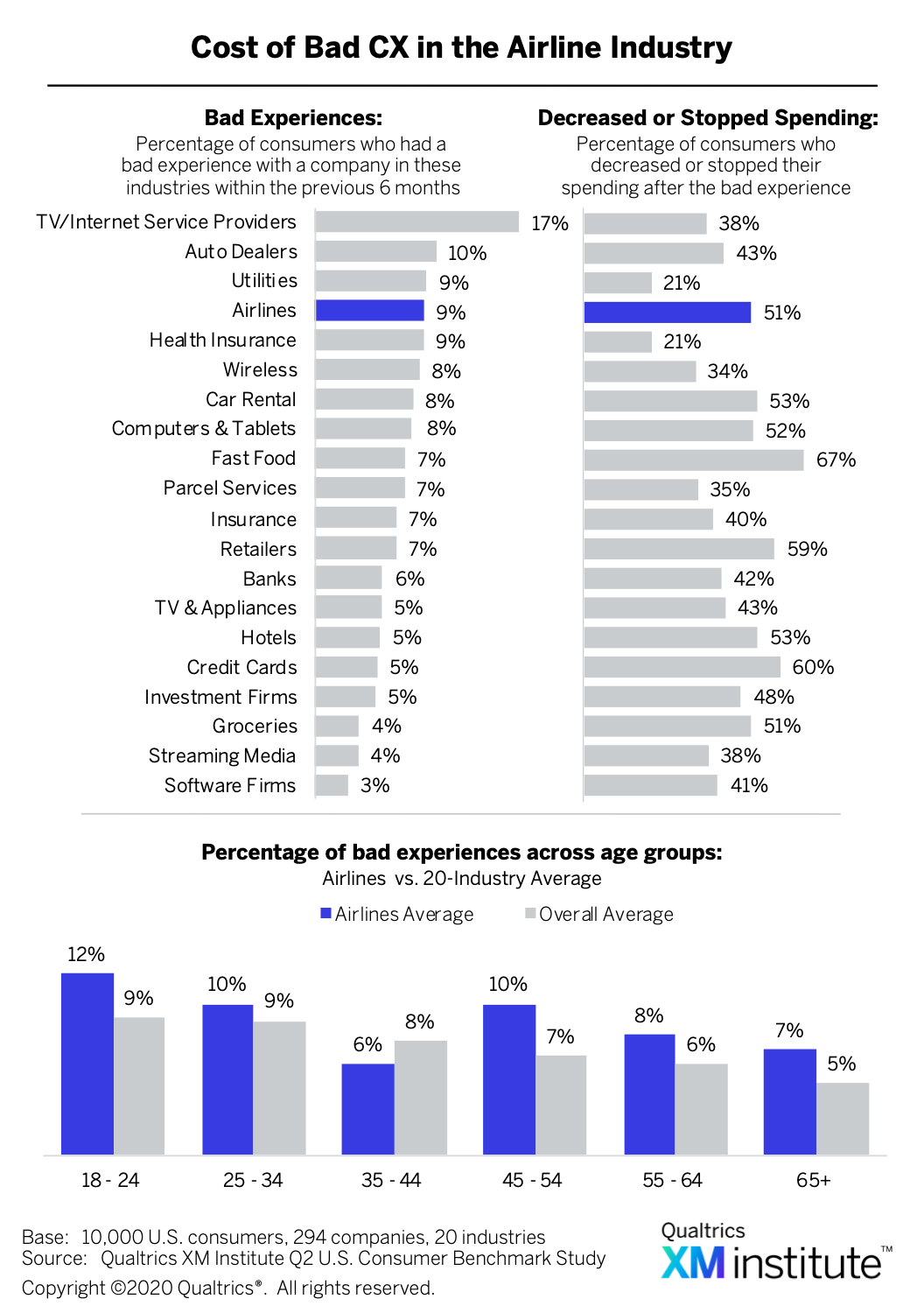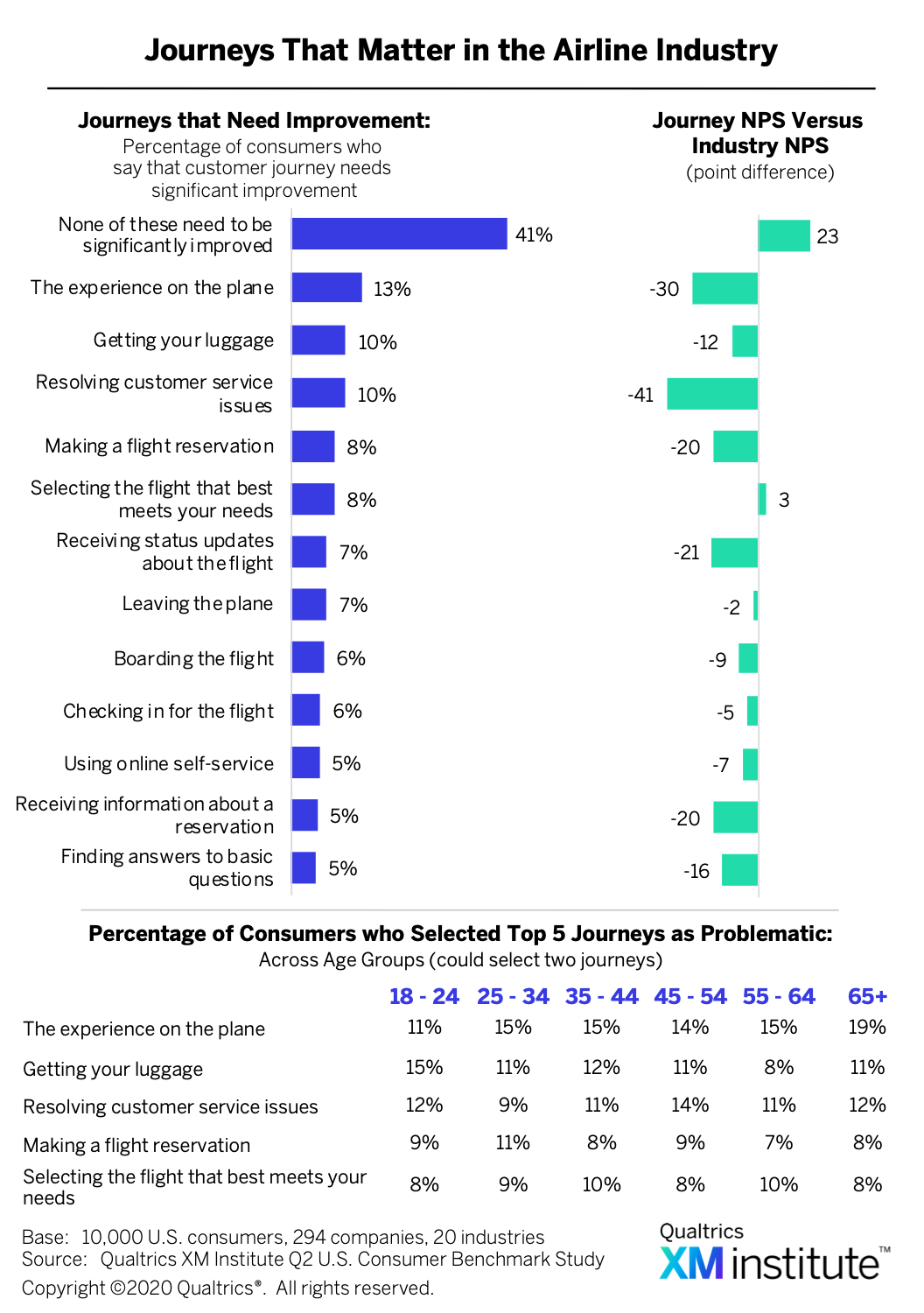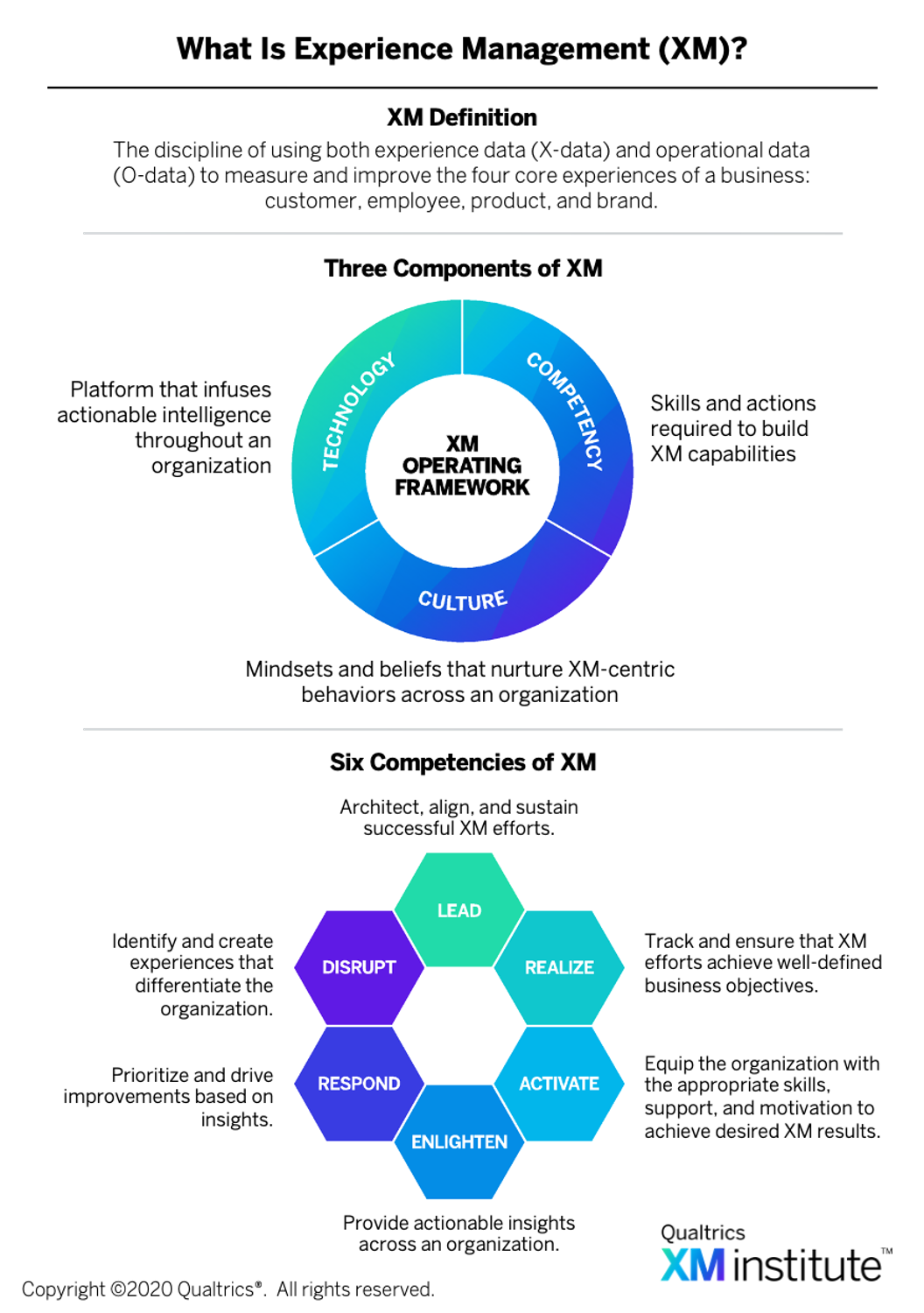Understanding the State of CX in the Airline Industry
How does the quality of customer experience differ across industries? To address this question, the XM Institute conducted a large-scale benchmark study where we asked 10,000 U.S. consumers to rate their recent interactions with 294 organizations across 20 industries.1 In this Industry Snapshot, we examine the state of CX in the airline industry. To develop this Industry Snapshot, we:
- Found the average XMI Customer Ratings – Overall for each industry. To generate the average CX rating for each industry, we asked respondents to evaluate their experiences with companies over the past 90 days.2 These questions – rated on a seven-point scale – covered the three components of an experience: success (were they able to accomplish their goals?), effort (how easy or difficult was it for them to accomplish their goals?), and emotion (how did the interaction make them feel?).3 We found the XMI Customer Rating – Overall for each of the 294 companies by averaging the ratings for these three experience components. We then calculated the average Customer Rating for each industry by averaging the Customer Ratings of the companies within each industry.4
- Calculated NPS. We asked respondents who had interacted with a company to answer the standard Net Promoter® Score (NPS®) question: How likely are you to recommend <company> to friends and colleagues? Consumers selected a response from 0 (not at all likely) to 10 (extremely likely). We then determined the percentages of each firm’s respondents who were promoters (selected 9 or 10), passives (selected 7 or 8), or detractors (selected between 0 and 6). We then calculated the NPS for each company by subtracting its percentage of detractors from its percentage of promoters.5
- Determined likelihood to repurchase and trust. We also asked consumers how likely they are to consider purchasing more products or services from the companies they had interacted with on a scale of 1 (extremely unlikely) to 7 (extremely likely). We also asked how likely they are to trust that the company would take care of their needs on a scale from 1 (do not trust at all) to 7 (completely trust).
- Established the frequency and effects of poor experiences. We asked respondents to identify which organizations they recently had a poor experience with and then asked, “Since the time that you had a bad experience with these companies, how have you changed the amount of money you spend with them?” They could answer that their spending completely stopped, it decreased, it didn’t change, it increased, or that they haven’t spent any money with that company.
- Identified the most broken customer journeys. To better understand which types of interactions are most likely to affect the customer’s perception of an organization, we asked respondents to identify which journey within a certain industry needs the most improvement. We also looked at the correlation between which journeys a customer identified as broken and how likely that customer was to recommend the company.
Airlines Deliver Average CX
When we looked at the current state of customer experience in the airline industry and how it compared to the broader CX landscape, we found that airlines:
- Earn average Customer Ratings scores. Airlines received an XMI Customer Rating – Overall score of 63%, tying for 11th place out of 20 industries (see Figure 1). In general, airlines’ average Customer Ratings track very closely with the 20-Industry average Ratings; however, airlines do diverge from the overall average when it comes to younger consumers. Customers between the ages of 18 and 24 give airlines an average score of 45% – compared with the 20-industry average of 50% – and those between the ages of 25 and 34 give them an average score of 53%, compared with the 20-industry average of 57% for this age group.
- Receive unremarkable Net Promoter Scores. We found a strong connection between customers’ experiences and their likelihood to recommend a company. Companies that significantly outperformed their industry’s average Customer Ratings also earned a significantly higher-than-average NPS (see Figure 2). When we looked at NPS in the airline industry specifically, we found that airlines’ scores are almost identical to the overall 20-industry average. If airlines want to break away from the pack, they should focus on the emotion component of experiences as, of the three elements of an experience, this is the one that most significantly impacts a customer’s likelihood to recommend. In fact, 86% of customers who gave an airline a high score for emotion say that they are likely to recommend the company.
- Appeal to older consumers. Customer experience is strongly related to a consumer’s likelihood to rebuy from a company – with a correlation coefficient of 0.85 (see Figure 3). The airline industry received average ratings when we asked customers how likely they were to repurchase from an airline. Older consumers are much more likely to say that they will rebuy from an airline, with 75% of customers over 65 and 74% of customers between 55 and 64 indicating that they will probably repurchase. Conversely, only 60% of 18- to 24-year-olds say the same.
- Fail to earn trust in younger consumers. While a customer’s experience with a company impacts their likelihood to trust that company, the correlation is slightly weaker than it is for their likelihood to recommend or repurchase (see Figure 4). While airlines frequently underperform the 20-industry average when it comes to young consumers, the disparity is more pronounced when it comes to trust. While the cross-industry average of 18- to 24-year-olds who say they are likely to trust a company is 59%, the airline industry average for this group is only 53%. On the other hand, airlines outperform the industry average by four percentage points with consumers who are 65 or older.
- Risk losing significant business from poor experiences. While airlines received average ratings in each of the other CX dimensions we examined, when it comes to delivering bad experiences, they are on the higher end of the spectrum (see Figure 5). Nine percent of customers who interacted with an airline over the previous six months say that they had a bad experience – one of the highest levels across the 20 industries. Of those customers who endured a poor experience, over half say that they decreased or stopped their spending entirely with the airline after that one bad interaction. Once again, younger consumers are least happy with airlines’ CX, with 12% reporting they had a bad experience with a company in this industry.
- Struggle with the in-flight experience. Thirteen percent of customers identified “the experience on the plane” as in need of significant improvement (see Figure 6). Customers who selected this journey as broken had an average NPS that was 30 points lower than the industry average. And while slightly fewer customers selected “resolving customer services issues” as the most in need of improvement, those who did gave airlines an average NPS that was 41 points lower than the industry’s average.
Propel Your Customer Experience to the Next Level
Airlines have historically competed almost entirely on price. However, as this race to the bottom becomes less sustainable, airlines have started to recognize the business value of delivering better experiences, such as stronger customer loyalty, positive word-of-mouth, decreased operating costs, reduced employee turnover, and lower cost to serve. To realize this potential business value and thrive in the changing competitive landscape, airlines must establish Experience Management (XM) as an organizational discipline by mastering six XM Competencies and 20 XM Skills (see Figure 7).6 These capabilities will help airlines succeed in the new environment by allowing them to:
- Continuously learn. Airlines with strong XM Competencies and Skills will be able to continuously collect and analyze feedback and behavioral signals from the people who interact with them – gathering the information necessary for understanding the experiences, perceptions, and attitudes of their customers, employees, and prospects. For example, airlines with robust XM capabilities will be able to identify which moments most affect the loyalty of key customer segments – such as luggage claim or resolving a customer service issue – and then establish listening posts that collect ongoing insights about the quality of those interactions. These insights will include experience data (X-data) like NPS or satisfaction scores as well as operational data (O-data) like flight delays or total spend. Airlines who are capable of combining these two types of data will be able to more accurately forecast the value of CX improvements and gain a deeper understanding of their customers’ actual experiences. For instance, an airline may uncover that satisfaction scores for its high-value customers are closely related to in-flight food and alcohol options.
- Propagate insights. Once airlines understand how the people who interact with them think, behave, and feel, they will then need to get those insights into the hands of the people across their ecosystems who are best equipped to act on that information. For example, airlines with strong XM skills will not only recognize that, say, boarding the plane is an important moment for customers, they will also be able to quickly share qualitative and quantitative insights about those experiences with the people who are directly and indirectly responsible for delivering them, such as flight attendants and ramp service agents. Furthermore, they will tailor both the content and the form of these insights for each role, with customized alerts triggered when certain criteria – such as a low NPS or CSAT score – are met.
- Rapidly adapt. Distributing customer insights in the right form to the right people across the organization will allow airlines to act quickly on the intelligence they’ve collected and shared, thus enabling them to rapidly create or improve experiences in a way that addresses people’s changing needs and expectations. For example, passenger feedback may highlight that waiting at luggage claim is a key pain point because customers feel anxious that their bag may be lost. Using these insights, an airline’s digital team could include an option for people to track their bags in the mobile app.
- Data comes from the Qualtrics XM Institute Q2 2019 Consumer Benchmark Survey – an online study of 10,000 U.S. consumers completed during May 2019. Survey respondents were representative of the U.S. Census based on quotas for age, income, ethnicity, and geographic region.
- See the XM Institute report, “2019 XMI Customer Ratings – Overall,” (September 2019). The XMI Customer Ratings – Overall are a continuation of the Temkin Experience Ratings. The Ratings were renamed after Qualtrics purchased Temkin Group in October 2018.
- We developed ratings for each of the three components of an experience – success, effort, and emotion – by subtracting the percentage of consumers who rated a company poorly from the percentage of consumers who rated it highly.
- Although consumers rated a number of companies for our survey, we only analyzed the ones that received at least 100 consumer responses. Ultimately, we examined data from 294 companies across 20 industries. For this Industry Snapshot, data on airlines comes from almost 4,000 respondents evaluating their experiences with eight large airlines.
- See the XM Institute report, “2019 XMI Customer Ratings – Consumer NPS,” (October 2019).
- See the Qualtrics XM Institute report, “Operationalizing XM” (July 2019).









